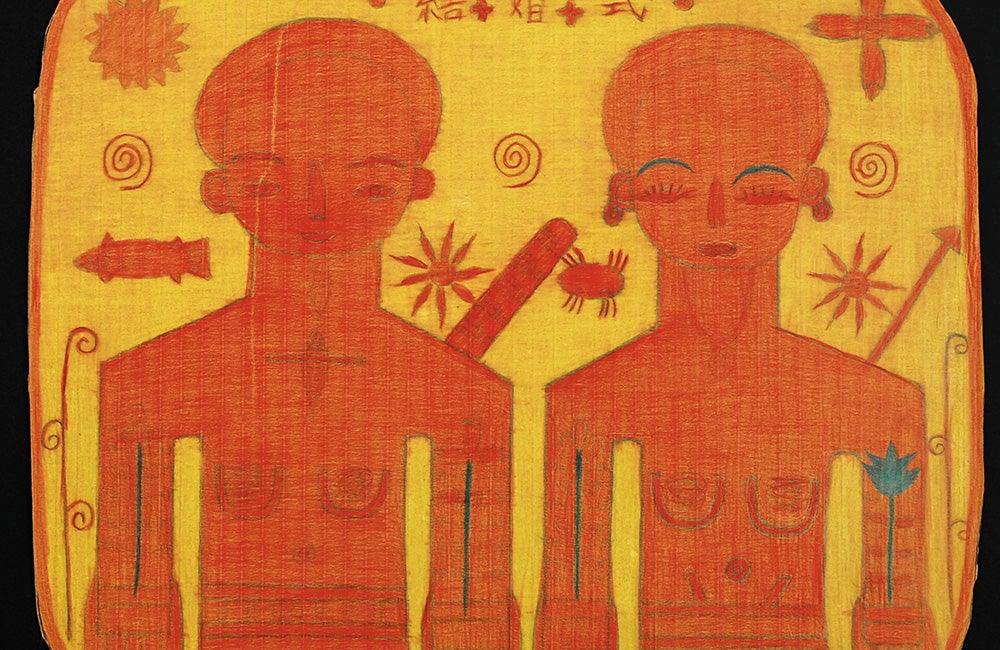First published: Fall 2008
Call it the new frontier. Now that the history of European Art Brut and of North-American Outsider/self-taught art has become institutionalised and canonised, and given that collectors, dealers and curators in the West appear more eager than ever for high-quality discoveries in the field, for some, Asia looms large as a territory just waiting to be explored.
At least one major event this year has shed some revealing light on Outsider/self-taught art activity in East Asia, and on Japanese self-taught artists in particular. It is Art Brut from Japan, an exhibition of the work of twelve artists that is on view at the Collection de l’Art Brut in Lausanne, Switzerland until January 2009. (A sister exhibition, Crossing Spirit: The Collection de l’Art Brut and Japanese Outsider Art, featuring works by several of the same Japanese artists and some others, as well as pieces from the Swiss museum’s collection, toured three museums in Japan until late July.)

In preparing both exhibitions in collaboration with Kengo Kitaoka and his associates in Japan, the Collection de l’Art Brut’s curatorial team learned that Outsider/self-taught art activity in Japan is currently centred around what are known in the West as art therapy programmes for disabled persons. Kitaoka is the most senior official in the department of social services for Shiga, a prefecture in southern Japan that is renowned for innovative facilities and programmes offered by social welfare organisations for people with disabilities.
In addition to overseeing these programmes, Kitaoka has developed a deep, personal interest in self-taught artists’ varied forms of creative expression. As a private arts patron, he serves as the head of the Borderless Art Museum NO-MA, a non-profit organisation that promotes Outsider Art and has a museum open to the public and located in a historic Japanese house in the town of Omihachiman, near Shiga’s prefectural capital, Otsu.
The Borderless Art Museum NO-MA identifies talented self-taught artists (who tend to be associated with social welfare organisations) and exhibits their work. One of the organisation’s goals is to help set up a legal infrastructure to aid self-taught artists who decide to sell their work. Kitaoka notes: ‘It is important that these self-taught artists be legally protected so that they cannot be exploited, especially since some cannot make decisions for themselves and must do so through designated representatives such as family members.’ Some of the artists whom Kitaoka and his collaborators have identified in Shiga and other parts of Japan, and whose works were on view in the exhibitions cited above, include Takashi Shuji, Yoko Kubota, Yoshimitsu Tomizuka and Takanori Herai.
Licensed by the government but privately run, Atelier Incurve in Osaka, also in southern Japan, bills itself as the ‘first vocational training facility for mentally disabled people in Japan focusing on the visual arts’. The twenty participants in its non-resident programme are selected for their ‘outstanding artistic talents and enthusiasm’. To date, several significant self-taught artists have emerged from Atelier Incurve’s programme. In recent years, some of their paintings, drawings and collages – including those of Katsuhiro Terao, Tomoyuki Shinki and Mitsuo Yumoto – have been offered for sale by New York’s Phyllis Kind Gallery in some of the first presentations of this kind of work outside Japan. At Atelier Incurve, which is housed in a modern building designed by its founder-director, Hiroshi Imanaka, a tightly knit sense of community prevails.
‘The feeling here’, says Imanaka, ‘is that our artists’ works are every bit as good as those of their counterparts in the contemporary art world, and we want to make them known internationally.’ Imanaka thinks big and has a keen sense of marketing. He promotes the artists associated with Atelier Incurve (and their artworks and the merchandise based on them, such as lapel pins, postcards, tote bags and bracelets) with the care befitting a prized brand.
This is an article extract; read the full article in Raw Vision #64




